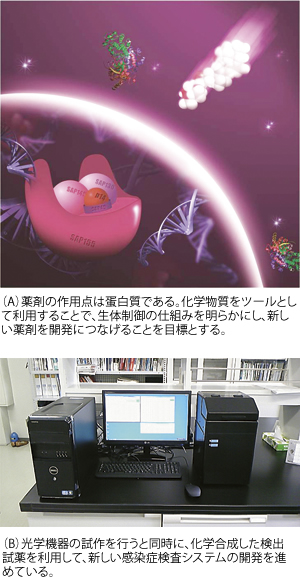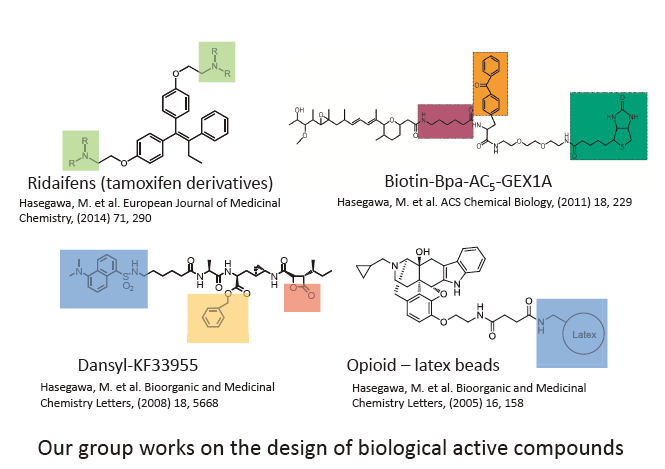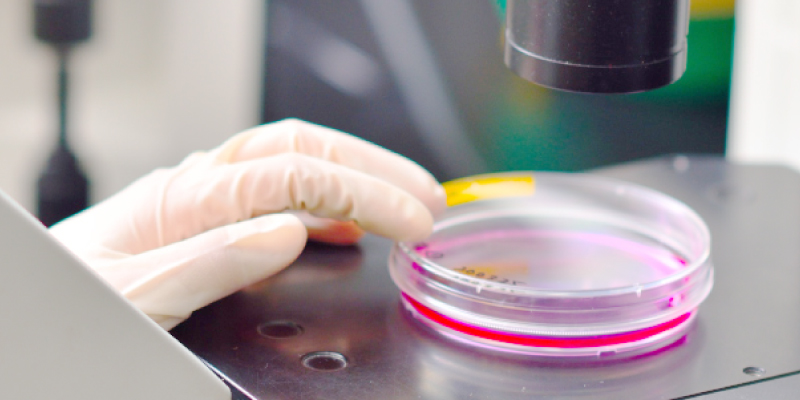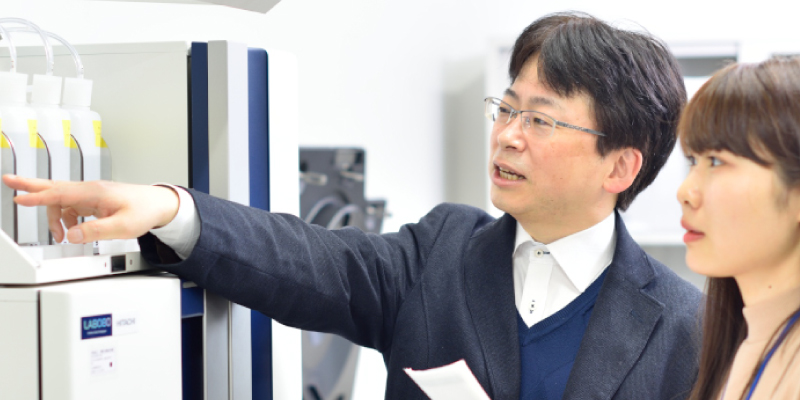フロンティアバイオサイエンス学科
 長谷川 慎(はせがわ・まこと)
長谷川 慎(はせがわ・まこと)
Makoto Hasegawa
専門分野/ケミカルバイオロジー、生物工学
研究キーワード/抗がん剤、バイオセンサー、高感度分析
職位:フロンティアバイオサイエンス学科長、教授
学位:博士(理学)(大阪大学)
- 大阪大学大学院理学研究科博士後期課程修了
- 東京工業大学フロンティア創造共同研究センター研究員を経て本学へ
研究テーマ
生体を構成するタンパク質は、他の分子の構造を見分けて働きかける性質を持っている。このような生体内特有の分子のふるまいを基にして、抗がん剤候補物質の探索や特定の物質を検知するバイオセンサーに応用することを研究テーマとしている。
(1)「分子標的抗がん剤」の開発

がんの化学療法では、がん細胞の特性を決める蛋白質や遺伝子の機能を抗がん剤でコントロールすることで治療に結びつけている。お薬が直接作用する分子は作用点と呼ばれる。その解明は、分子標的治療の基礎となる重要な研究テーマである。われわれは、興味深い生理活性を持つ抗がん剤候補物質の作用点(レセプター分子)を明らかにし、そこに作用する分子を探し出すことで、新しい薬剤の創出につなげたいと考えている。現在までに、数種類の低分子量化合物の作用点を明らかにし、誘導体を合成してより標的に作用しやすい化合物を作り出している。(詳しくは業績論文1,5を参照)
(2)「一分子蛍光分析法」を応用した感染症診断法の機器開発
近年、たったひとつの分子から発せられる蛍光を測定することで様々な情報を得る一分子蛍光分析と呼ばれる技術が発展している。このような原理を病原体の検出に応用し、ウイルスやバクテリア、あるいはそれらと関係した病原因子を高感度・迅速に検出するための検出機器の開発を進めている。(詳しくは業績論文2を参照)
(3)微量物質の簡単検出を実現する「金属メッシュデバイス」センサーの開発
メッシュ状の構造を持つ金属薄膜を利用して、大きさによって微粒子をふるい分け、その後、赤外線を照射して表面残存量を検出する技術をバイオに応用している。例えば、細胞や微生物を分離し、薄膜の表面に付着した量を決めることができる。このような検出と分離の両方の機能を兼ね備えたユニークな技術をどのバイオ分野に応用できるか、いろいろとアイデアを試している。(詳しくは業績論文3を参照)
(4)「試験管内人工進化法」による機能性ペプチドの創生
アミノ酸が複数連結した中程度の分子量を持つ分子をペプチドとよぶ。ランダムなペプチドの配列ライブラリーから、特定のタンパク質に対して作用するペプチドを見つけ出すことで、新しい人工の機能性分子を創生し、利用する技術を開発している。現在は、抗がん剤の標的となるタンパク質に作用してその働きを阻害するペプチドの開発を行っている。(詳しくは業績論文4を参照)
| 研究の応用領域 | 産官学連携で求めるパートナー |
|---|---|
| 医薬品・診断薬の開発、バイオ分析機器の開発 | 医薬品・診断薬開発、材料やデバイス開発、微細加工の関連企業、バイオ機器メーカー、大学、国・地方自治体の研究機関 |
Topics of research
(1) Proteosomal degradation of ubiquitinated proteins plays a pivotal role in the regulation of critical cell functions. Aberrant degradation of key regulatory proteins by the proteasome perturbs these functions, causing uncontrolled cell proliferation and decreased cell death, which are hallmarks of tumorigenesis. Indeed, several proteasome inhibitors have been proposed as anticancer drugs. However, many of these inhibitors have drawbacks, including side eff ects and short life-time. Thus, the development of new types of proteasome inhibitors is required to broaden the spectrum of inhibitors with fewer side-eff ects. In an attempt to search for new proteasome inhibitors, we have found that a novel tamoxifen (TAM) derivative, ridaifen-F (RID-F), inhibits the human 20S proteasome. Furthermore, we have prepared several conjugates that possess various peptides connected to RID-F. Conjugates with peptides consisting of seven amino acid residues signifi cantly inhibited the 26S proteasome. Particularly, RID-F conjugated to an octaarginine peptide (a so-called cell-penetrating peptide) inhibited intracellular proteasome activities and induced cell death in a drug-resistant myeloma cell line. (See References No. 1 and 5)
(2) We have designed and developed a compact immunosensor based on the principle of fl uorescence fl uctuation spectroscopy. It enables us to detect fl uorescence signals from assemblages of virus and fl uorescence-labeled antibody. This prototype instrument detected rotavirus in stool suspensions using the fluorescence-labeled antibody without the need for a prior isolation step, providing a result within minutes. These features may be useful for point-of-care testing, as well as the prevention and eradication of viral infections. (See Reference No. 2)
 (3) A metal mesh device (MMD) is a thin nickel mesh with periodic microstructures consisting of square apertures. The MMD operating as a band-path filter in the range of 100 THz electromagnetic waves is suitable for optically sensing mesh-captured particles, and simultaneously functions as a sieve for separating particles according to their size. We are developing techniques using this MMD to selectively capture and detect particular cells from a mixture containing other types of cells. The MMD is useful for recovery of cultured cells from cultures without cellular damage, which may facilitate large-scale culture in cell biotechnology, because centrifugation, a laborious process for harvesting cells, becomes dispensable. (See Reference No. 3)
(3) A metal mesh device (MMD) is a thin nickel mesh with periodic microstructures consisting of square apertures. The MMD operating as a band-path filter in the range of 100 THz electromagnetic waves is suitable for optically sensing mesh-captured particles, and simultaneously functions as a sieve for separating particles according to their size. We are developing techniques using this MMD to selectively capture and detect particular cells from a mixture containing other types of cells. The MMD is useful for recovery of cultured cells from cultures without cellular damage, which may facilitate large-scale culture in cell biotechnology, because centrifugation, a laborious process for harvesting cells, becomes dispensable. (See Reference No. 3)
主な業績論文等
- Tanaka M, Zhu Y, Shionyu M, Ota N, Shibata N, Watanabe C, Mizusawa A, Sasaki R, Mizukami T, Shiina I, Hasegawa M (2018) Ridaifen-F conjugated with cell-penetrating peptides inhibits intracellular proteasome activities and induces drug-resistant cell death. European Journal of Medicinal Chemistry, 146, 636–650.
- Hasegawa M, Wandera EA, Inoue Y, Kimura N, Sasaki R, Mizukami T, Shah MM, Shirai N, Takei O, Shindo H, Ichinose Y (2017) Detection of rotavirus in clinical specimens using an immunosensor prototype based on the photon burst counting technique. Biomedical Optics Express 8, 3383-3394.
- Hasegawa M, Yamamoto K, Shirai-Kitanishi E, Mori K, Inoue Y, Inagaki Y, Sasaki R, Mizukami T, Shirai M, Miura Y, Ogawa Y, Banju M, Kamba S, Kondo T (2016) Surface coating of a metal mesh device sensor with gold to improve the separation and sensing of mammalian cell. IEEE Sensors Journal, 16, 5129-5135.
- Hayakawa Y, Matsuno M, Tanaka M, Wada A, Kitamura K, Takei O, Sasaki R, Mizukami T, Hasegawa M (2015) Complementary DNA display selection of high-affi nity peptides binding the vacuolating toxin (VacA) of Helicobacter pylori. Journal of Peptide Science 21, 710-716.
- Hasegawa M, Yasuda Y, Tanaka M, Nakata K, Umeda E, Wang Y, Watanabe C, Uetake S, Kunoh T, Shionyu M, Sasaki R, Shiina I, Mizukami T (2014) A novel tamoxifen derivative, ridaifen-F, is a non-peptidic and small-molecule proteasome inhibitor. European Journal of Medicinal Chemistry, 71, 290-305.






